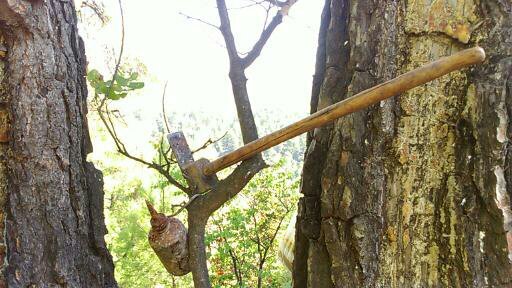RESINE CULTURE
After the extraction of Magnesite, resin cultivation has played an essential role over a century and continues to develop our place's economy and society.

But let's see what resin is and what is the importance of its production.
From antiquity to the present day
In ancient times, the nymph Pittys disguised herself as a pine tree to avoid the forest god Pana. So somewhere in northern Evia, the myth must have taken place since, in its entirety, it is covered with pine trees as well as the borders that touch the sea.
Resin cultivation has been known in Greece since at least 300 BC, when we find the first reference to the work of Aristotle’s student, Theophrastus, “On Plants”.
In the same work, reference made to a rosin tar production process, which used for lighting, for the sealing of the wooden joints of the floating transports of the time, etc. Later, in the Byzantine era, the liquid fire was based on resin and, in the revolution of ’21, the product of the Turkish fleet.
Resin, the precious tear secreted by the wounded pine!
The resin culture lasts about nine months. It starts in February – March, with the cleaning of the tree basement as the opening of the paths. Follows the first chipping of the pines (Aleppo pine), a small incision or two, depending on the diameter of the pine, which is drenched with an irritating caustic substance, from where the resin is released and ends up in plastic bags, nailed just below the incision, which is replaced when filled.
The whole season 8-9 “adzes” will follow and at the end of October, depending on the weather conditions (if it rains, the pine cools and the flow stops or slows down) and begins the harvest, the production is concentrating in barrels or large bags and finally comes the sale.
Today, the main derivatives of the resin – a product renewable, exportable, friendly to humans and the environment – are turpentine and rosin, while 70 by-products are among them: Cosmetic paints, varnishes, synthetic rubber, adhesives, waterproof covers, printing ink, perfume raw materials, hair fasteners, hair removal wax, artificial dentures, plastics, etc. It is also used for sealing ships, wine, paints, shoes, while in recent years it is intended mainly for industry.
The resin is also used in medical pharmacy, its medicinal properties are empirically known in resin-producing villages, where many use it in liquid form for wound healing.
In Greece, resin production has been declining in recent decades, except the last decade when the situation reversed despite the reduction in its selling price by producers and a dramatic reduction in state subsidies to them. In northern Evia, around 1000 families live from resin cultivation, while every year, about 5.5 million euros enter the economy of Evia from resin and the insurance funds almost 220 thousand euros.
In Greece there are two handicrafts, one in Istiaia and the other in Chalkida. The primary quantity for the further processing of resin and export of its derivatives is carried out by industry in Greece located in Megara, Attica, which, although stable in the market of the first for many decades, benefits from the monopoly situation that has been created.

Forest's cares and guardians
The contribution of resin growers has been and still is enormous—deforestation of the forest from low shrubs, dry branches, etc. Opening or clearing roads to approach their trees. Make sure the fire protection zones remain open. With good organization, they take care of the protection of the trees. They are the reason resinous pine forests still exist today.
It is difficult for an arsonist or poacher to set foot in their captivity. This is because so many fires were extinguished in the beginning thanks to their immediate intervention and so many others the Fire Department has consulted them to approach the place of fire, since they know the forest better than anyone. “Forests that are resinous, difficult to burn” are commonly said in Evia.
The importance of the resin produced in Evia lies in its quality and its future is considered important. Based on studies by Greek universities and scientists, it is judged that resin is a perfect fuel improver because it has the ability to retain moisture in the fuel and therefore the engine, thus improving its efficiency and purity, reducing pollutants, prevents the formation of ice in the fuel and piping, mainly in gas-powered vehicles. According to the experiments, only 2.5-5 kg of resin is needed in one ton of fuel in a two-hour treatment to reduce the humidity in it by 70%!
Forest Cooperative of Pili Evia.
In almost every village of Northern Evia there is a Forest Cooperative, while in Pili the Forest Cooperative until recently, exceeded one hundred members. In the past, the Pili Forest Cooperative bought retsina and exchanged it, in addition to money, for grain or oil, etc., which were used by households for their livelihood.
Today, our Cooperative owns a property with privately-owned offices and a warehouse, where in the same building there is another department that is rented to a private person as a business space. At the same time, in Pili beach, the Cooperative owns another property that is also rent to a private person as a business space. The forest in which the Pili forest workers-resin workers, is public and is leased by the Cooperative. Then it is drawn and rented every five years to the interested members who want to work on resin production. The work of the Cooperative is not limited only to the resin production, but also to the selective cutting of wood and its sale, the cleaning and thinning of the forest, for easier access to it and to its fire protection.
